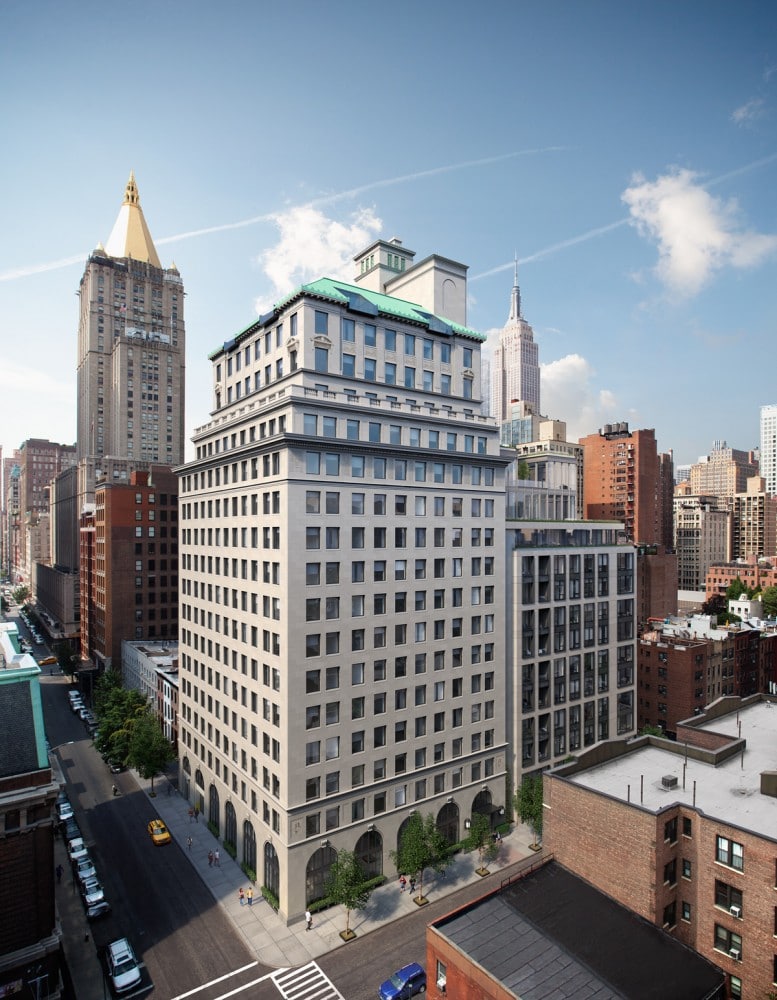They say opposites attract, and certainly this seems to be the case with luxury Gramercy apartments 88 and 90 Lexington Avenue. Their addresses may be nearly identical, but these two buildings embody the aesthetics of two distinct periods in architectural history, one honoring the classical past, the other embodying the mid-century enthusiasm for all things pared-down and modern. But they have much in common, too, not just in their shared location, but in the timelessness of their livable interiors. So which is for you? Take a closer look and decide if you’re an “88 Lex” or a “90 Lex” at heart.
From the Outside
Built in 1927, 88 Lexington Avenue has seen much of Manhattan grow up around it. The classic Art Deco limestone building captures the proportions and style of the golden age of skyscrapers. Nineteen stories tall, it has all the geometric curves and details of the era with none of the fussy ornament associated with the Beaux-Arts “wedding cake” apartment houses that came before it. Art Deco was just one manifestation of the machine age, in which designers married the aesthetics of power and progress with the materials that signified cosmopolitan luxury, from snakeskin and mother-of-pearl to marble and limestone. The late 1920s were a period of sophisticated fun paired with innovation in the worlds of music, fashion, contemporary art, and design. If 88 Lex was an article of clothing, it would probably be Coco Chanel’s understated “little black” day dress from 1927, the instant classic that remains the go-to choice for chic women nearly a century later. There is something about it that never seems to go out of style. Time has been good to 88 Lex, too: its exterior is in superb condition, allowing its clean, geometric design to take center stage.
By contrast, 90 Lexington Avenue is newer, more compact, and more geometric than its next-door neighbor, with larger windows that flood the building’s interiors with natural light. Built in 1958 at the peak of high modernism in America, the structure hails from a time when designers were ready to leave ornament and decoration behind and let architectural form speak for itself. Immediately following the back-to-back traumas of the Great Depression and World War II, designers and architects became eager to try something original in order to fully move on from the baggage of the preceding decades and centuries. Modernism represented the way forward. This meant no frills, no scrolls, no arches, just the space and geometric framework needed to create a home that could be filled with personalized color and character.
Home furnishings from this period, from the lively fabrics of Alexander Girard to the furniture of Charles and Ray Eames and Henry Miller, demonstrated a love of color and a well-developed sense of play perfectly suited for the blank interiors provided by the creations of Modernist architects. Modernist architecture wasn’t stuffy, it was just setting the stage for the vibrant textiles, ceramics, art, photography, and fashion that would fill its sleek, unadorned spaces. Indeed, if 90 Lex were a cherished outfit, it would probably be a cool 1957 Balenciaga sack dress ready for a dramatic Art Smith necklace to accompany it.
From the Inside
Inside 88-90 Lex, some of the elements these two buildings have in common can be see in their shared lobby, which reflects a successful convergence of Art Deco and post-war Modernism. Shared as well are their amenities such as the pool and gym, private cinema, and concierge service. The interiors of 88-90 Lex residences reveal a graceful blending of styles in bold, stone-surfaced kitchens, high-ceilinged open-plan layouts, and generous proportions in everything from bathtubs to master bedroom suites. While the understated décor is beautiful on its own, it also invites a new owner’s touch in the form of the color choices, fabrics, art, and distinctive decorative items that make each home unique.
